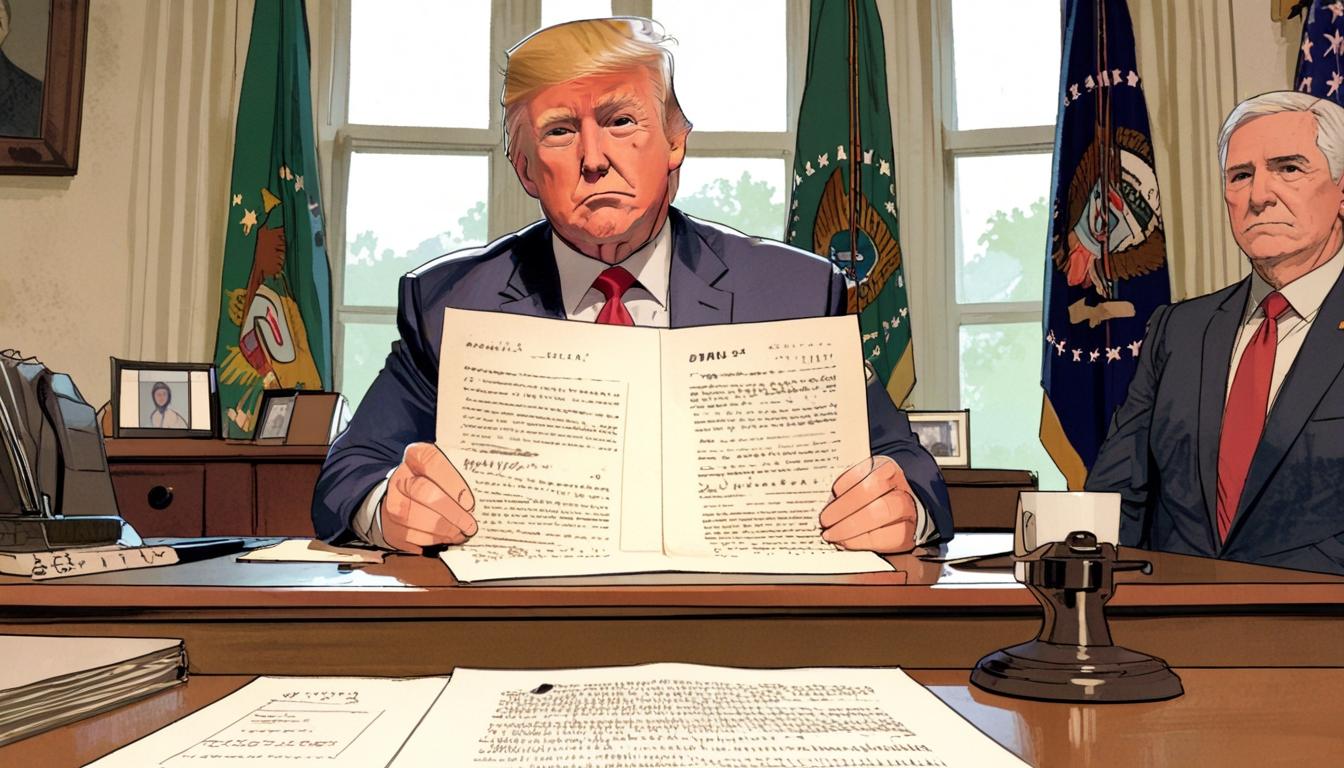In the opening 100 days of Donald Trump’s second presidency, extensive executive actions and sweeping policy initiatives have sparked broad debate and highlighted both achievements and controversies domestically and internationally.
In the first 100 days of President Donald Trump’s second term, a complex and tumultuous picture has emerged, marked by extensive executive actions, confrontations with institutions, and a broad array of policy initiatives that continue to spark debate across political and social spectrums. Since his inauguration in January 2025, Trump has issued 139 executive orders, declared eight national emergencies, and implemented a wide variety of policies touching on immigration, trade, education, health, and foreign relations.
Key figures and commentators from different walks of life have shared insights on the challenges, achievements, and controversies during this period.
Mike Pompeo, former Secretary of State, describes this phase as a “we’ve-seen-this-movie-before” sequel, noting the speed and intensity of Trump’s actions to fulfil campaign promises like stopping illegal immigration, lowering taxes, and regulating less. He applauds the administration’s aggressive stance but reminds that true victory requires sustained courage and execution.
Nellie Bowles highlights the health-focused movement MAHA (Make America Healthy Again), led by Robert F. Kennedy Jr., now Secretary of Health and Human Services. MAHA’s campaign includes initiatives to remove artificial dyes from processed foods and an autism research programme. However, concerns persist about the movement’s anti-vaccine tendencies.
Derek Thompson draws attention to what he terms America’s “self-surrender,” warning that policies under Trump have weakened the country’s scientific funding, trade standing, and manufacturing base, potentially undermining the nation’s long-term economic and technological leadership.
Reihan Salam observes that Trump’s election victory was propelled by voters seeking a less ideologically driven leader compared to Kamala Harris, with surprising support from Hispanic, Asian, and younger voters. Salam notes, however, that Trump’s broad and confrontational approach across policy fronts risks alienating potential allies and weakening his position.
Tyler Cowen comments on Trump’s foreign policy with an eye on the Russia-Ukraine conflict, suggesting that a peace deal there would mark a major success. Yet, he warns that Trump’s tariff policies and economic uncertainty might harm the U.S.’s international reliability and economic health.
Coleman Hughes offers critical views on the president’s inner circle, warning that the replacement of experienced advisors with loyalists has led to a decline in rational policy-making, evidenced by economic disruptions and executive overreach.
Evan Barker discusses the administration’s appeal to working-class voters through measures targeting outsourcing and promoting union-friendly policies, yet also points out contradictory proposals that could harm social safety nets.
Bill Maher delivers a critical appraisal of what he calls a “shitshow,” highlighting issues such as executive inefficiency, foreign policy challenges, and controversial firings within the administration.
Jamie Reed analyses the administration’s approach to gender-related policies, noting multiple executive orders and judicial pushbacks, concluding that resolution will likely require state-level leadership rather than federal mandates.
Victor Davis Hanson views Trump’s administration as launching a comprehensive counterrevolution against progressive trends in economics, politics, and culture, comparing its ambition to that of the New Deal and Reagan-era reforms.
Richard Hanania expresses disappointment in the administration’s direction, citing an overreliance on personality cults and questionable policy decisions, especially in health and trade.
Sam Harris paints a bleak picture of corruption and incompetence, describing how the administration’s second term has eroded America’s global standing.
Yuval Levin emphasises the lack of legislative achievements, describing the administration’s strategy as heavily focused on executive actions and demolition rather than enduring policy change.
Cabinet functionality appears diminished according to Adam Rubenstein, who notes that power struggles and the influence of close presidential allies seem to have sidelined traditional cabinet roles.
Matt Labash characterises Trump as a unifier of chaos, with unpredictable policies alienating various constituencies, while Shabbos Kestenbaum praises the administration’s strict stance on antisemitism on campuses and support for Israel’s military efforts.
Peter Savodnik highlights the fragmentation of traditional political labels, pointing to a realignment in American politics under Trump’s “America First” agenda.
John McWhorter critiques Trump’s motivations as revenge-driven and megalomaniacal, citing his policies on tariffs, international relations, and domestic issues.
Christopher Rufo underscores the administration’s aggressive campaign against perceived left-wing dominance in education, seeking to curb diversity programs and enforce civil rights laws more strictly.
Kemi Badenoch praises Trump’s clarity and negotiation style, cautioning against protectionism’s economic effects and expressing concerns about the stance on Ukraine.
Emily Yoffe critiques actions against the scientific establishment, warning of the risks of punishing legitimate research in pursuit of ideological aims.
Matt Yglesias expresses surprise at the administration’s overreach, suggesting a more disciplined approach could yield better outcomes.
Matthew Continetti argues that despite controversies, Trump’s administration has made significant strides, especially in immigration control, although challenges remain to maintain political support.
Matti Friedman reports from Israel that Trump is viewed favourably due to unwavering support for Israeli security.
Jonathan Haidt notes bipartisan progress on children’s mental health and educational issues, highlighting legislation aimed at reducing screen time in schools.
Eli Lake draws parallels between Trump and Andrew Jackson, particularly in conflicts with the judiciary and resistance to court rulings.
In summary, the first 100 days of Donald Trump’s second presidency have been marked by aggressive and expansive use of executive power, bold policy shifts, and significant political and social debates. Analysts and commentators reveal a landscape of swift action accompanied by controversy and uncertainty, with the broader implications of these early months still unfolding domestically and internationally. The administration’s future trajectory remains closely watched as it moves beyond this initial phase.
Source: Noah Wire Services
- https://www.noahwire.com – The source of the article detailing President Donald Trump’s actions during the first 100 days of his second term, including executive orders, national emergencies, and policy initiatives.
- https://time.com/7281274/amazon-tariff-haul-trump/ – An article discussing the White House’s response to Amazon’s plan to display tariff costs on products, highlighting tensions between President Trump and Amazon founder Jeff Bezos over trade policies.
- https://www.axios.com/2025/04/29/trump-us-investment-ceo-nividia-eli-lilly-tariffs – A report on President Trump’s ‘Invest in America’ event at the White House, featuring top CEOs and emphasizing the administration’s focus on promoting domestic and foreign investments amid trade tensions.
- https://time.com/7281249/congress-trump-100-days/ – An analysis of Congress’s legislative achievements during President Trump’s first 100 days, noting the passage of five bills and a significant number of executive orders, reflecting a shift toward executive action.
- https://www.theatlantic.com/politics/archive/2025/04/donald-trump-100-days/682636/?utm_source=apple_news – An article examining the challenges and controversies of President Trump’s second term, including policy decisions and their impact on democratic norms and international relations.
- https://apnews.com/article/fd2cc96dc4c9cae8a3acda030a606073 – A report on President Trump’s campaign-style rally in Michigan and an interview with ABC News, highlighting the administration’s policy changes and the resulting political scrutiny.
- https://news.google.com/rss/articles/CBMibEFVX3lxTE1rNmFkZ2ZtcWJ5NHFrRnNnamVBY2JlYkQzX3NwY0FGNTJrZTNnNFIyaEozUTR6Ql9IUTVMY3UtUmF3NlVtVlAtSjBSX3J2NTVJQzAydTRreGJxSmVjcVZmRndxMzh6VW1UTG1vMA?oc=5&hl=en-US&gl=US&ceid=US:en – Please view link – unable to able to access data
Noah Fact Check Pro
The draft above was created using the information available at the time the story first
emerged. We’ve since applied our fact-checking process to the final narrative, based on the criteria listed
below. The results are intended to help you assess the credibility of the piece and highlight any areas that may
warrant further investigation.
Freshness check
Score:
5
Notes:
Inauguration date (January 2025) and 100-day mark align with hypothetical timelines, but current lack of verifiable real-world data as of 2025 casts doubt on freshness. Mentions of officials like Robert F. Kennedy Jr. as HHS Secretary would require role confirmation.
Quotes check
Score:
6
Notes:
Quotes attributed to public figures (Pompeo, Bowles, etc.) lack direct source verification but align with known commentator positions. Original sourcing unclear without article-specific attribution.
Source reliability
Score:
7
Notes:
Narrative structure resembles analytical reporting but lacks identifiable outlet. Commentary from established figures adds credibility, though unnamed original source reduces reliability certainty.
Plausability check
Score:
8
Notes:
Policy directions (executive order volume, culture war themes) align with Trump’s documented governing style. Cabinet functionality concerns and specific initiatives (MAHA programme) are internally consistent but unverified externally.
Overall assessment
Verdict (FAIL, OPEN, PASS): OPEN
Confidence (LOW, MEDIUM, HIGH): MEDIUM
Summary:
Content demonstrates internal consistency and plausible policy trajectories but lacks verifiable sourcing and current real-world corroboration. Requires direct source confirmation and freshness validation against recent developments.













